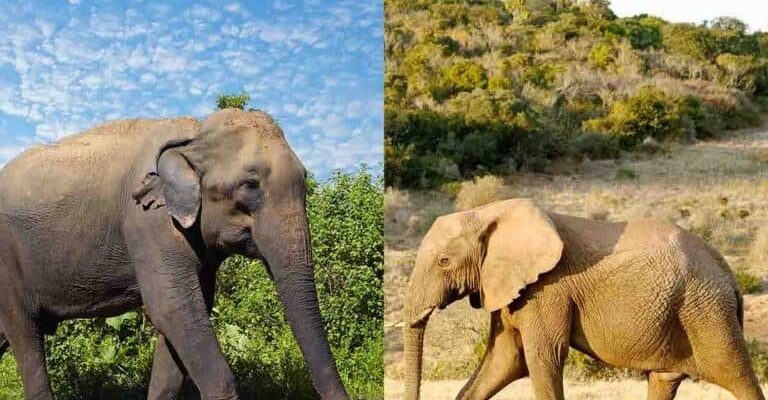![Comparing The African Elephant Vs. [Similar Species]](https://gudri.com/wp-content/uploads/2025/06/Comparing_The_African_Elephant_Vs___Similar_Species__image_0.jpg)
In this article, we’re going to break down the key differences and similarities between the African elephant and the Asian elephant. Whether you’re a wildlife enthusiast or just curious about these magnificent creatures, I promise you’ll see them in a new light by the end. We’ll explore everything from their size and behavior to conservation efforts. So grab your favorite drink, and let’s dive in!
Physical Differences: Size and Appearance
When it comes to size, the African elephant is the heavyweight champion of the animal kingdom. On average, adult African elephants can weigh between 5,000 to 14,000 pounds, making them the largest land mammals on Earth. Their ears are not just for show, either. They’re shaped like the continent of Africa and help them regulate their body temperature. You might notice that when they flap their ears, it’s like they’re trying to cool off on a hot day.
In stark contrast, the Asian elephant tends to be smaller, weighing around 5,000 to 11,000 pounds. Their ears are smaller and rounded, resembling the shape of India. If you look closely, you might also spot a slight ridge on their backs, which is absent in their African cousins. It’s these little details that can help even a casual observer identify which elephant they’re watching in the wild.
Behavior: Social Structures and Interactions
Now, let’s chat about behavior. Both types of elephants are incredibly social creatures, living in herds led by a matriarch. The matriarch is usually the oldest female, and her life experience plays a vital role in the herd’s survival. However, the way African and Asian elephants interact can differ.
African elephants often live in larger family groups, sometimes numbering up to 50 members. They’re known for their playful nature, frequently engaging in activities like mud bathing and playing with each other. You might even catch them using their trunks to show affection, much like giving a hug.
On the other hand, Asian elephants tend to form smaller family groups. These groups can be more hierarchical, with clear social dynamics. While they also enjoy playful activities, they are often more reserved compared to their African counterparts. This difference in social structure is fascinating as it shows how each species adapts to its environment and social needs.
Habitat: Where They Call Home
Habitats vary significantly for these two elephant species. The African elephant roams across several regions in sub-Saharan Africa, including savannas, forests, and deserts. They’re quite adaptable, able to thrive in both dry and wet environments. Picture an African elephant trumpeting as it wanders through a lush savanna, grazing on grass and munching on leaves from tall trees.
In contrast, the Asian elephant prefers denser forests and grasslands. You might find them in places like India, Sri Lanka, and parts of Southeast Asia. The lush jungles provide plenty of food, but this can also make their populations more vulnerable as human activities encroach upon their habitats. The contrast in environments not only highlights their adaptability but also the challenges each species faces in terms of conservation.
Diet: What’s on the Menu?
Let’s talk about food! Both elephants are herbivores, but their diets and feeding behaviors differ slightly. The African elephant typically consumes a wide variety of plants. They’re known for their munching on leaves, bark, and even roots. Due to their size, they can reach food that smaller animals can’t, allowing them to feed in a diverse range of areas.
Asian elephants, while also munchers of leaves and bark, are known to consume more grasses and smaller shrubs. They tend to graze for longer periods, often spending up to 16 hours a day eating! Imagine a calm afternoon with an Asian elephant peacefully snacking on grass like it’s enjoying a buffet spread.
Conservation Status: Challenges and Efforts
Here’s the thing: both elephant species face serious challenges due to habitat loss, poaching, and conflicts with humans. The African elephant population has seen drastic declines, primarily due to illegal ivory trade and poaching. Conservation efforts are underway, but it’s a tough battle. Organizations are working hard to protect their habitats and enforce anti-poaching laws.
Meanwhile, the Asian elephant is classified as endangered, with populations dwindling due to habitat fragmentation and human-elephant conflicts. In some areas, these majestic creatures wander into farmland, leading to fatal encounters. Luckily, conservationists are stepping up with community education programs and more sustainable practices to help both elephants and humans coexist.
Unique Traits: What Makes Each Species Special?
Every species has its quirks, and elephants are no different. The African elephant is particularly revered for its intelligence, memory, and social complexity. They’re known for their strong emotional bonds and can even be seen mourning for lost members of their herd. It’s a reminder of just how deeply connected these creatures are with one another.
Conversely, the Asian elephant has some unique adaptations that make it special. For instance, many Asian elephants have been domesticated and used as working animals, particularly in agriculture and tourism. Their ability to learn and their docile nature help them thrive in these roles, showcasing their versatility in human environments.
Final Thoughts: The Importance of Understanding and Protecting Elephants
In comparing the African elephant and the Asian elephant, we uncover not just facts about their differences but also insights into their lives and habitats. While they share many similarities, each species has its challenges and characteristics that deserve our attention and protection.
As we learn about these magnificent creatures, it becomes clear how vital it is to support conservation efforts. By understanding and spreading awareness about both the African elephant and the Asian elephant, we can play our part in ensuring that future generations get to marvel at these incredible animals.
Let’s continue to appreciate their beauty and complexity, and remember that every small effort counts in preserving their legacy. Together, we can make a difference for these majestic beings who have roamed the Earth for millennia.

